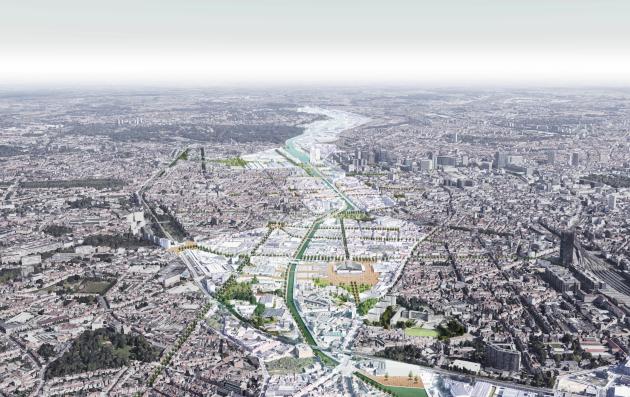Date of label : 29/10/2024
-
Brussels Capital Region , Belgium
-
Size of city : 1.208.542 inhabitants

Central canal territory.
Summary
The Brussels Canal runs for about 14 km across the Brussels-Capital Region (BE), from north to south through the valley of the river Senne, forming the region’s longest undeveloped open space. The canal area is a former industrial, socially-deprived zone, characterised by many diverse spaces. In 2015, the Canal Plan was launched to transform it into a vibrant, sustainable and inclusive urban mixed-use centre. Since 2019, a complementary plan, the Beeldkwaliteitsplan (BKP), has helped strengthen social and ecological coherence, and the quality of open spaces in the canal area.
The solutions offered by the Good Practice
The Beeldkwaliteitsplan (BKP) guides open space developments in the Brussels Canal area, aiming to strengthen its identity, provide quality public spaces, and improve social links between districts divided by the canal. The BKP, developed by the Brussels Planning Agency (known as perspective.brussels) in collaboration with local stakeholders, acts as a guide and strategic framework for developers and designers.
A follow-up committee, project guidance, and a central procurement agency (CPA) promote BKP goals, creating a momentum for transformation. The procurement agency offers developers access to a multidisciplinary design team.
Since the BKP was launched several projects have implemented it, and additional funding could accelerate the transformation process.
Building on the sustainable and integrated urban approach
The BKP addresses urban challenges along the Brussels Canal with a flexible and integrated approach. It offers context-specific recommendations for environmental, social, and public space solutions. The plan aims to transform the canal area into an ecological corridor and an inclusive public space, by improving social coherence, creating greener spaces, and fostering a cleaner, climate-resilient city that encourages active lifestyles.
Serving as a design guide, the BKP requires developers and consultants to incorporate its recommendations into their projects and plans. New challenges arising from project meetings, environmental assessments and participation with the public can easily be met because of the flexibility of the BKP’s application. The plan can also regularly be updated to stay relevant. In 2024 additional studies for greening and lowering of the canal quays, and for the partial re-opening of the Senne River, were incorporated into the BKP, as was a detailed lighting study.
Based on participatory approach
The BKP embodies a shared vision, for open spaces along the Brussels Canal, developed by regional and local stakeholders, with input from private developers, businesses and NGOs. Updates are discussed by a follow-up committee, involving the same actors, fostering partnerships at local, regional, and federal levels. The central procurement agency (CPA) awards projects to developers, ensuring BKP principles are integrated through dialogue with relevant stakeholders.
As a result of public-private collaboration, projects balance urban, social, landscape, ecological, and economic goals. Public and private entities are encouraged to apply BKP principles.
Eleven public authorities participate in the CPA, and 15 are part of the follow-up committee, which ensures effective governance and development. Since 2019, Perspective has overseen about 100 projects in the canal area, establishing the BKP as a key reference for collaborative urban transformation.
What difference has it made?
The Brussels Canal area, the former industrial heart of Brussels, is densely-built, neglected and culturally diverse. It suffers from high pollution, limited green and public spaces, and its deprived neighbourhoods have high unemployment and poverty rates. Home to 17% of the Brussels-Capital Region’s population (under 200 000 people), it is now experiencing demographic growth and attracts many daily visitors.
The BKP addresses these challenges by promoting inclusive social, green and public spaces, and enhancing the physical and mental well-being of the area’s inhabitants. Local and regional authorities, including the Port of Brussels, helped develop this shared vision, and now assist in implementing projects. The initiative benefits less-favoured communities, through better connectivity around the canal, climate-resilience, and improved open spaces for recreation and nature.
Why this Good Practice should be transferred to other cities
The BKP’s collaborative, place-based approach, and innovative multi-level governance, offers an inspiring and replicable model replicable for other cities.
It supports key policy frameworks:
- Sustainable Development Goals (SDGs): SDG 3 (Good health and well-being), SDG 10 (Reduced inequality), SDG 11 (Sustainable cities and communities), and SDG 13 (Climate action).
- The Urban Agenda for the EU, the European Green Deal, and the Territorial Agenda 2030.
- The Regional Plan for Sustainable Development, which identifies the Brussels Canal area as a priority development zone, and it also enables buildings of cultural value to be reutilised.
Adapting the BKP practice to local contexts is crucial, as shown by several BKP-inspired initiatives in Belgium. Successful transfer requires a collaborative governance approach, broad stakeholder involvement, a central procurement agency, and a guidance plan adapted to a city’s specific local contexts.
The BKP has been shared widely in Belgium, to help establish other framework agreements. Various international delegations have also visited Brussels to learn about the BKP practice and experience.
